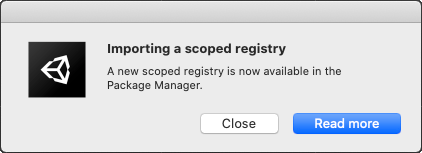スコープ付きレジストリ
Scoped registries allow Unity to communicate the location of any custom package registry server to the Package Manager so you can access several collections of packages at the same time.
Here are some important concepts to help you understand this feature:
| Concept | 説明 |
|---|---|
| package registry server | An application that keeps track of packages and provides a place to store them. In Unity’s Package Manager window, all packages registered on Unity’s registry appear in the list panel when you select the Unity Registry context. |
| package manager | 何が利用可能かをユーザーに伝え、ユーザーがプロジェクトのために要求するパッケージをダウンロードしてインストールするアプリケーションです。Unity では独自の Package Manager を実装していますが、他にも同様のアプリケーションがいくつかあります。 |
| scope | Defines a package name or namespace (in reverse domain format), such as com.example.mycompany.animation or com.example. When a user requests a package, the Package Manager fetches the package from the registry that best matches the scope. For more information, refer to Managing scoped registries for a project below. |
スコープ付きレジストリと対話する方法は、ロールによって異なります。
- パッケージプロバイダーは、Unity レジストリ に加えてカスタムレジストリサーバーを設定し、カスタムパッケージをホストと配布を行います。
- パッケージコンシューマーはプロジェクトごとにスコープ付きレジストリを設定して、カスタムパッケージプロバイダーのレジストリサーバーにアクセスします。
スコープ付きレジストリの完全性とセキュリティ
ノート: パッケージプロバイダーは、パッケージレジストリサーバーの設定が Unity の利用規約、特に Unity Package Guiding Principles & Guidelines に準拠していることを確認してください。Unity は、知識や制作物の共有を促進するために Package Manager へのアクセスを提供していますが、サードパーティ製品のマーケットプレイスとして提供しているわけではありません。
パッケージのコンシューマーとして、スコープ付きレジストリをインストールする際には、他のサードパーティ製ソフトウェアをインストールするときと同じレベルの注意を払ってください。
- Install scoped registries only from trusted sources, because the packages in those registries can contain executable code.
- Beware of third-party registries that might be harmful or capture data without appropriate controls. Also beware of third parties misrepresenting themselves as Unity, or sanctioned or supported by Unity.
スコープ付きレジストリーの利点
スコープ付きレジストリは、以下ために役立ちます。
-
ツール、ライブラリ、その他のアセットを配布することで新しい機能を提供
プロバイダーとして独自のレジストリを作成し、バージョン番号を付けてツールやスクリプト (または他のタイプのアセット) を配布することができます。バージョン番号は、セマンティックバージョニング に基づいて、更新で API の重大な変更またはマイナーな修正が導入されたかどうかも示します。また、Package Manager はパッケージの依存関係 をサポートしているので、他のパッケージのコードに依存することができます。
ユーザーにとって、Package Manager でサードパーティのカスタムパッケージをブラウズしたりインストールしたりする体験は、Unity のパッケージの場合と同じです。
-
既存の Unity のパッケージ機能を拡張
As a consumer, you can have a seamless experience where the custom package overrides the Unity package without having to manually change registries or explicitly install a different package version. This is because you can map packages to a specific registry so that Package Manager fetches from either the Unity registry or a custom package registry server.
-
クローズドネットワーク環境でパッケージにアクセス
Some organizations work inside a closed network, which makes it difficult to access Unity’s package registry. In these cases, the organization can set up their own package registry on a server inside their closed network. The network administrators can then periodically synchronize with Unity’s package registry to make sure the scoped registry has the latest set of packages available.
If you’re a package consumer, refer to Managing scoped registries for a project for information about connecting to an existing custom package registry server in your Unity project. If you’re a package producer, refer to Sharing your package for information about supported package registry servers. This information also includes links to information on how to set them up to use with scoped registries.
Note: If you’re setting up a scoped registry that points to a package registry server with restricted access, you can configure Package Manager to pass your npm authentication token to the server. For more information, refer to Scoped registry authentication.
スコープ付きレジストリのインポート
If you’re working in a shared project, and another user adds a scoped registry to the project, Unity warns you that another user added a new scoped registry.

When you click Close, the Package Manager project settings window appears so you can add, modify, or remove scoped registries for your project.
If you click Read more, Unity opens the page you’re currently reading in your default web browser.
Tip: To access the Package Manager project settings window at any time, use the main menu in Unity (Edit > Project Settings, then the Package Manager category). You can also select Advanced Project Settings from the advanced settings menu in the Package Manager window.
プロジェクトのスコープ付きレジストリの管理
To manage the scoped package registries in your project, you can either edit your project manifest file directly or use the Package Manager project settings window to let Unity change the manifest for you.
The project manifest uses a scopedRegistries property, which contains an array of scoped registry configuration objects. Each object has the following properties:
| プロパティ | JSON 型 | 説明 |
|---|---|---|
| name | 文字列 | The scope name as it appears in the user interface. The Package Manager window displays this name in the details panel. For example, "name": "Tools". |
| url | 文字列 | The URL to the npm-compatible registry server. For example, "url": "https://mycompany.example.com/tools-registry"Note: Not all registry providers are compatible with Unity’s Package Manager. Make sure the package registry server you’re trying to add implements the /-/v1/search or /-/all endpoints. |
| scopes | 文字列の配列 | パッケージ名の正確な一致か、名前空間のいずれかでパッケージ名にマップするスコープの配列。ワイルドカードとその他のグロブパターンはサポートされていません。 例えば、 "scopes": [ "com.example", "com.example.tools.physics" ] ノート: このような設定は、パッケージが 逆ドメイン名表記 に従っていることを前提としています。これにより、com.unity が、 com.unity.timeline や com.unity.2d.animationなどの com.unity 名前空間に一致するすべてのパッケージ名と同等であることが保証されます。 |
Package Manager が、どのレジストリからパッケージを取得するかを決定するとき。パッケージの name と scopes の値を比較して、scopes が最も一致するレジストリを見つけます。
例えば、以下のプロジェクトマニフェストには、 General と Tools の 2 つのスコープ付きレジストリがあります。
{
"scopedRegistries": [
{
"name": "General",
"url": "https://example.com/registry",
"scopes": [
"com.example", "com.example.tools.physics"
]
},
{
"name": "Tools",
"url": "https://mycompany.example.com/tools-registry",
"scopes": [
"com.example.mycompany.tools"
]
}
],
"dependencies": {
"com.unity.animation": "1.0.0",
"com.example.mycompany.tools.animation": "1.0.0",
"com.example.tools.physics": "1.0.0",
"com.example.animation": "1.0.0"
}
}
Package Manager が com.example.animation パッケージを検索するとき、com.example 名前空間がその名前に最も近いと判断し、“General” レジストリからパッケージを取得します。
Package Manager が com.example.tools.physics パッケージを検索すると、“General” レジストリには、パッケージ名と完全に一致するスコープがあります。
Package Manager が com.example.mycompany.tools.animation パッケージを検索するとき、Package Manager は com.example.mycompany.tools 名前空間がその名前に最もよく合致することを発見し、“Tools” レジストリからパッケージを取得します。“General” スコープにも一致しますが、com.example 名前空間は一致と言えるほど近くありません。
When the Package Manager looks up the com.unity.animation package, the Package Manager doesn’t find a match in any of the scoped registries. In this case, it fetches the package from the default registry.